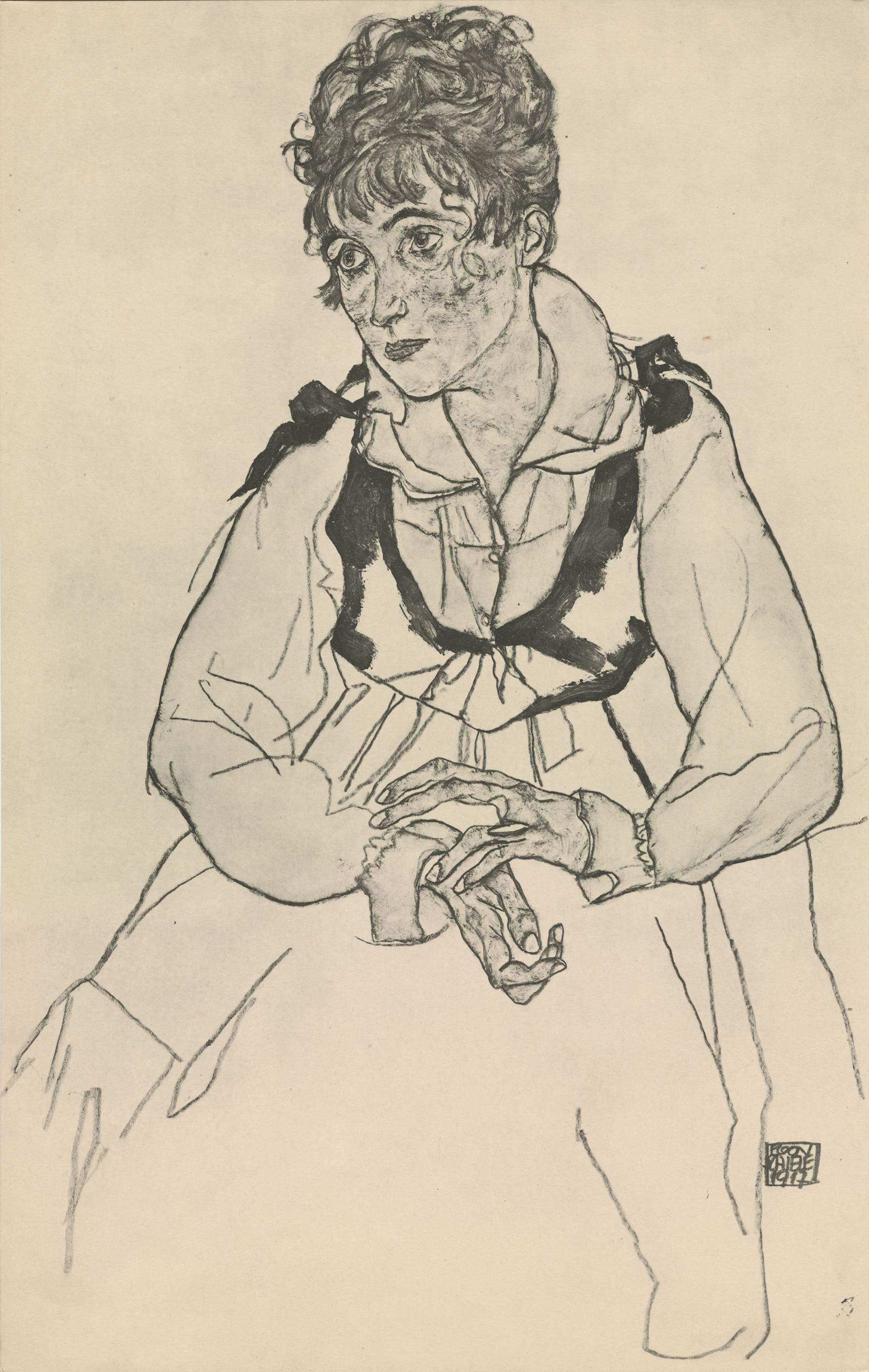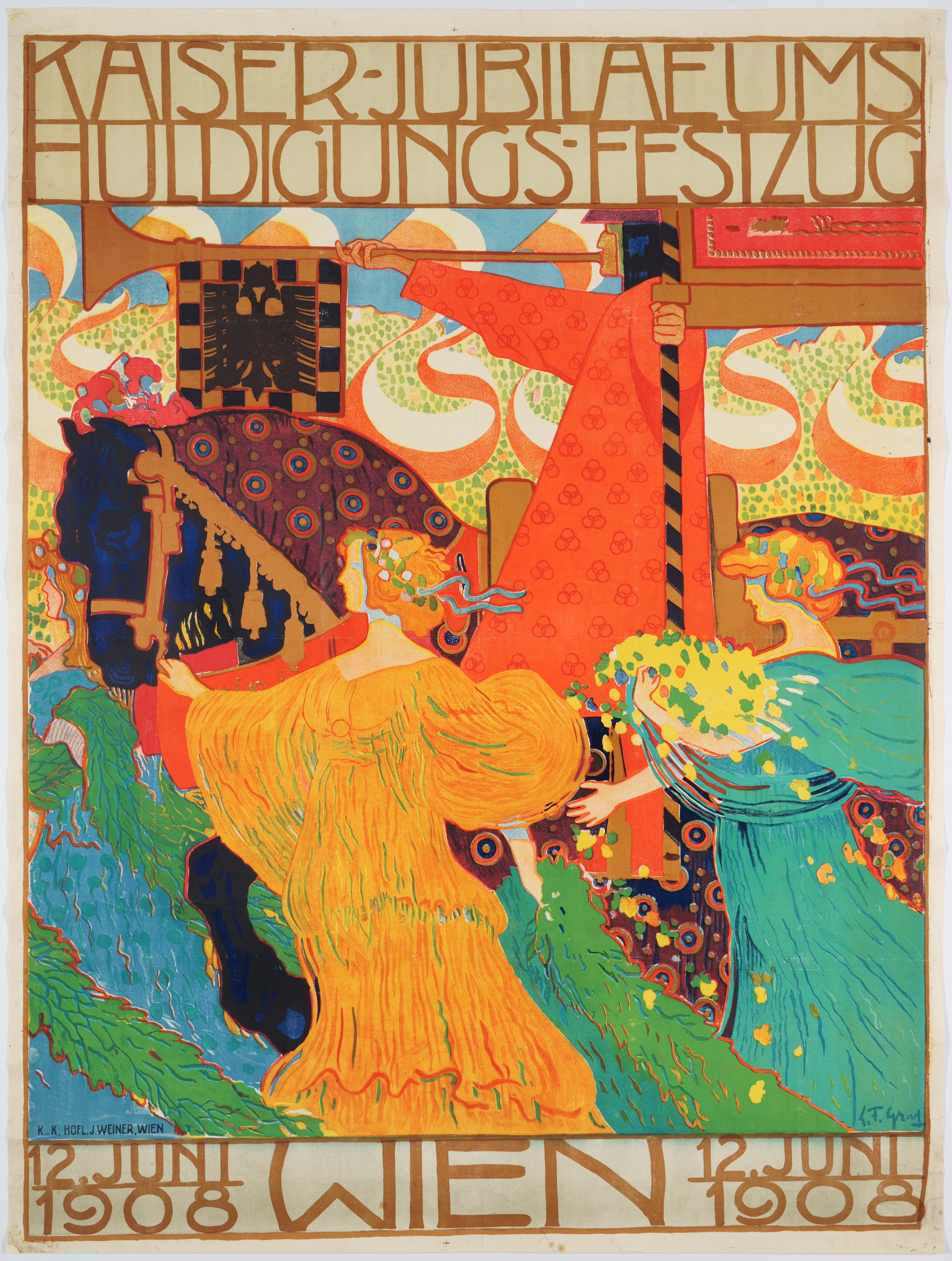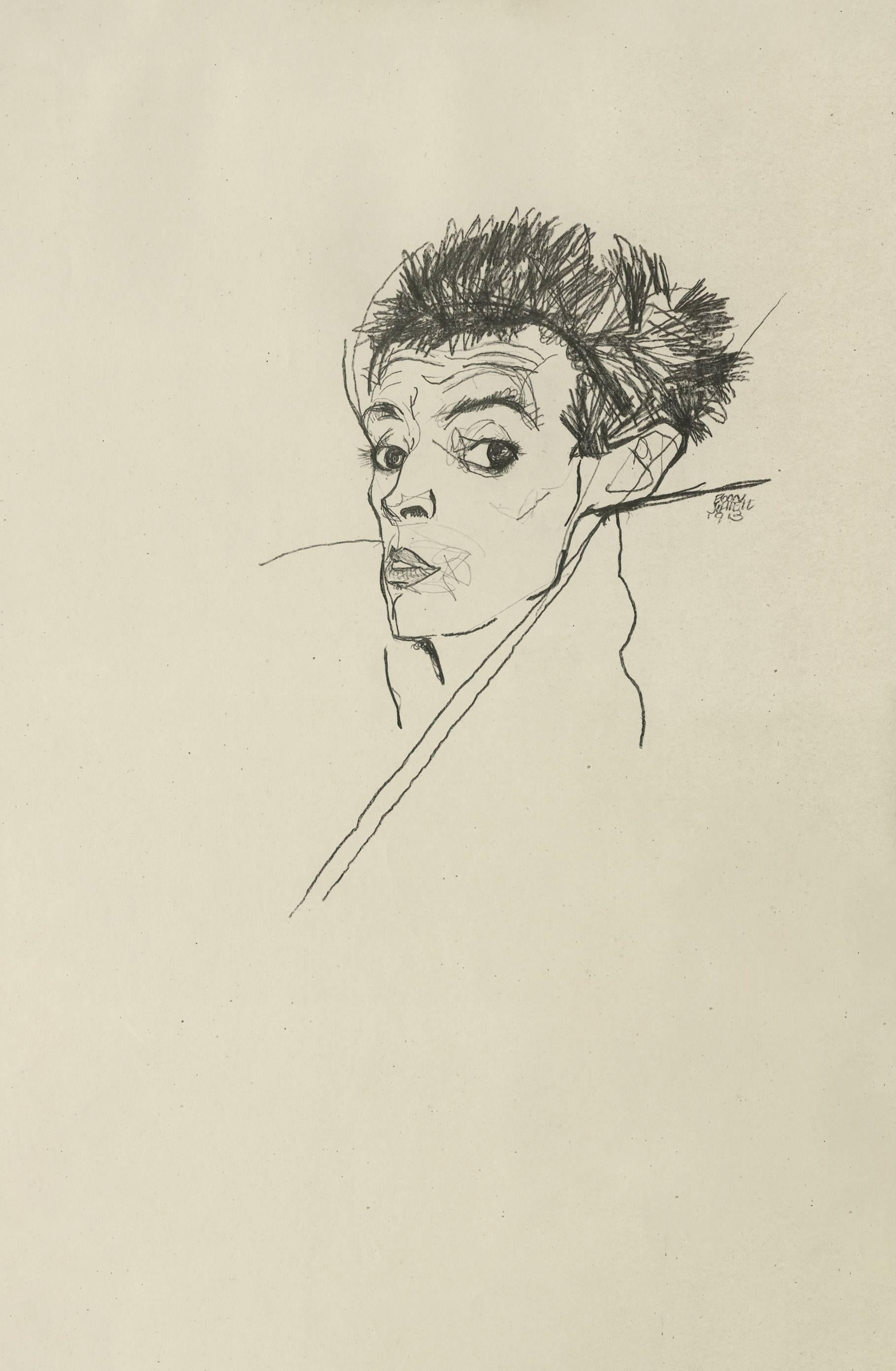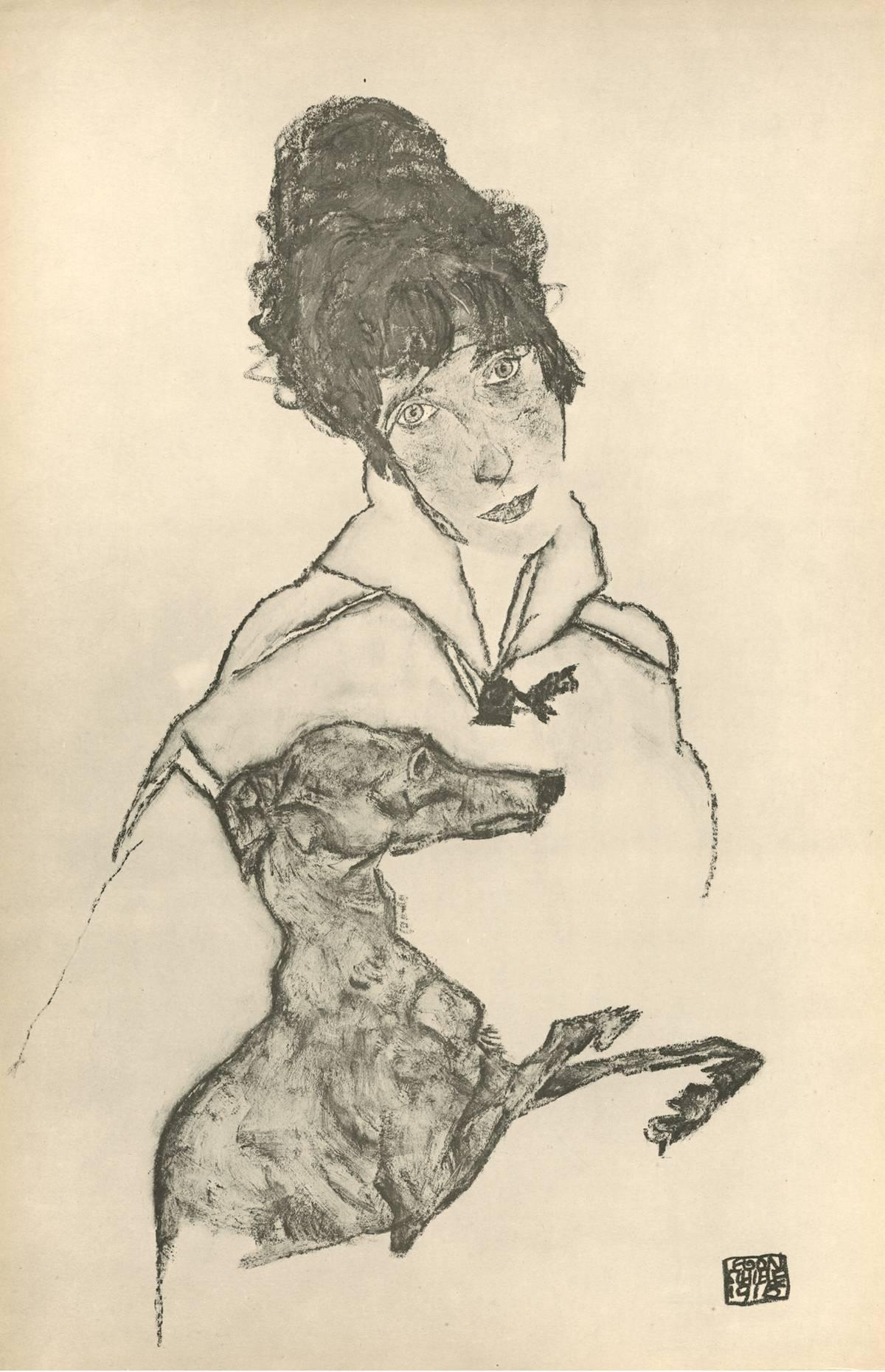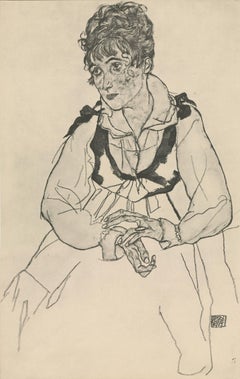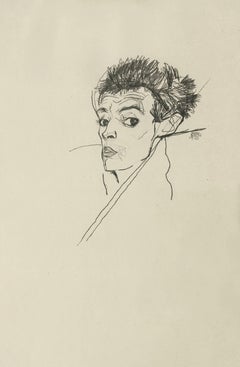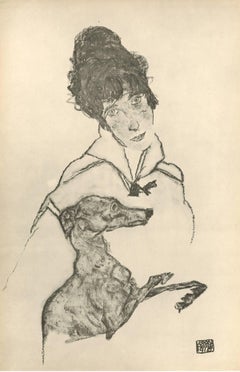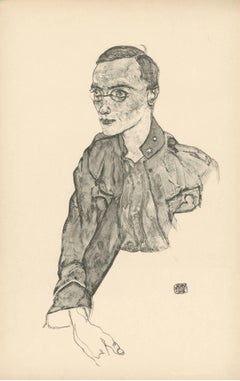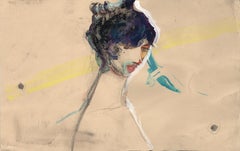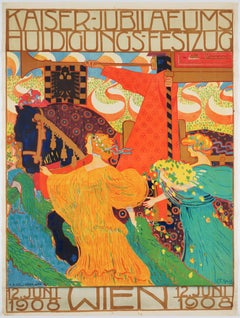Items Similar to E. Strache, Handzeichnungen folio, "Portrait Study (Head of a Girl)" Collotype
Want more images or videos?
Request additional images or videos from the seller
1 of 6
(after) Egon SchieleE. Strache, Handzeichnungen folio, "Portrait Study (Head of a Girl)" Collotype1920
1920
About the Item
after Egon Schiele (1890 – 1918), AUSTRIA
“ART CANNOT BE MODERN, ART IS PRIMORDIALLY ETERNAL.” -SCHIELE
Defiantly iconoclastic in life and art, Egon Schiele is esteemed for his masterful draftsmanship and precocious insight into the human condition. Part of the first wave of Austrian Modernism, he was swept away by the Viennese fascination with the tension between Life and Death (known in the works of Freud and his later interpreters as Eros and Thanatos). Life, identified with attraction, love, sexuality, and reproduction, and Death, represented by distortion, disease, repulsion, and hysteria, often appeared in the same composition, thereby suggesting the frightening life cycle of the human mind and body.
Young throughout his career, Schiele universalized his childhood traumas, thriving libido, insecurities, fears, and longings. His contorted line, jarring contrasts, and flat areas of color, demonstrate an early alliance with Expressionist philosophy and artists who were relentlessly frustrated by conventionality in all its forms. Schiele’s work embodied man’s disorientation and confusion in a seemingly absurd world, a world plagued by disease and war. It continues to be astonishingly relevant today, not just because it helped define Modernism but also because it revealed the dark and immutable aspects of the human condition.
Handzeichnungen, is a fine art portfolio consisting of 15 collotype prints after original watercolors and drawings by Egon Schiele, four of which are in color. Published by Verlag Eduard Strache, Vienna, Prague, Leipzig, 1920, in an edition of 510: the first group numbered I - X were hand signed by Schiele and included an original drawing by Schiele. The art images were printed by Kunstanstalt Max Jaffe, Vienna; the portfolio with printed written pages was printed by Gesellschaft fur Graphische Industrie, Wien VI.
Although Egon Schiele’s Handzeichnungen portfolio was published posthumously in 1920, there is evidence that on the heels of his highly successful sold-out run number-ing 400 copies with his 1917 portfolio of monochromatic prints entitled Zeichnungen, Schiele was already planning a bigger and more elaborate follow-up upon his untimely death in 1918. The final print in Handzeichnungen features a stunning color print of a Kneeling Female (semi-nude) from the collection of Kunsthandlung Richard Lanyi. This same image was the seventh featured in Schiele’s Zeichnungen portfolio from 1917 published by Richard Lanyi. Clearly, Schiele’s first publisher approved of Handzeichnungen’s publication as he contributed one of the featured works. He also saw the opportunity to showcase Schiele’s work from what had been an entirely mono-chromatic collection of prints to an even more highly sophisticated portfolio including color collotype print work. A copy surely was to be found in his gallery/salon, a hot-bed of intelligentsia activity.
Posthumous printed portfolios such as Handzeichnungen are a continuation of the tradition Gustav Klimt and Egon Schiele helped to develop and popularize in Vienna during their lifetimes. Schiele's hand joined so many ways of seeing to capture the erotic, the intellectual, the esthetic. In the early years of 20th century Vienna, there was no clear separation between fine art, science, sociology and politics or philosophy; the cross-pollinating character of Viennese intellectual life was robust. Rather than cut-off and confined to the university, intellectual activity thrived in social spheres such as coffee houses and salons. Huge overlap existed among these inter-disciplinary circles. In a city numbering approximately 2 million, only a few hundred comprised the cultural and political elite. Schiele exhibited widely, helped to organize exhibitions and had earned such a following that upon the death of Gustav Klimt in February the year following Zeichnungen’s publication, Schiele had naturally taken up the torch as Klimt’s successor. As leader of the 49th Vienna Secession Exhibition in 1918, the responsibility to create an exhibition poster and art for the main gallery fell on Schiele’s shoulders. Critical accolades for his Expressionist work made certain Schiele’s leading position in the world of art. Shiele’s posthumously published portfolio is, no doubt, an art piece as well as a key into the intellectual circles which characterized early-20th century Vienna. Schiele’s portfolios were the very picture of Viennese life: they were collaborations between a fine artist; art collectors; art promotors; idea disseminators; scientists; and printers.
The collotype print form was at this time the preferred method of reproducing fine works of art. The printer of Schiele’s Zeichnungen and Handzeichnungen portfolios was Max Jaffe, a Viennese specialist in fine art collotypes. This dichromate-based photographic process had been invented in 1856 and predates lithography. The gelatin plates required delicate preparation involving light exposure, washing, and curing. They were inked with a velvet or leather roller and printed using a hand proof process with a light-pressured press. Collotype plates could not be re-used; the limited edition prints made from colloid inks were stable and posed no danger of fading like other photographic processes of the time. In fact, the fine reticulations created on the plates using the collotype process produced prints of extremely high quality. Lithography later replaced the collotype process which has now become nearly a lost art.
- Creator:(after) Egon Schiele (1890 - 1918, Austrian)
- Creation Year:1920
- Dimensions:Height: 18.75 in (47.63 cm)Width: 11.5 in (29.21 cm)
- Medium:
- Movement & Style:
- Period:
- Condition:Literature: see "Egon Schiele: The Complete Works" by Jane Kallir. 1990. Pg. 610 (#2229).
- Gallery Location:Chicago, IL
- Reference Number:1stDibs: LU46736447422
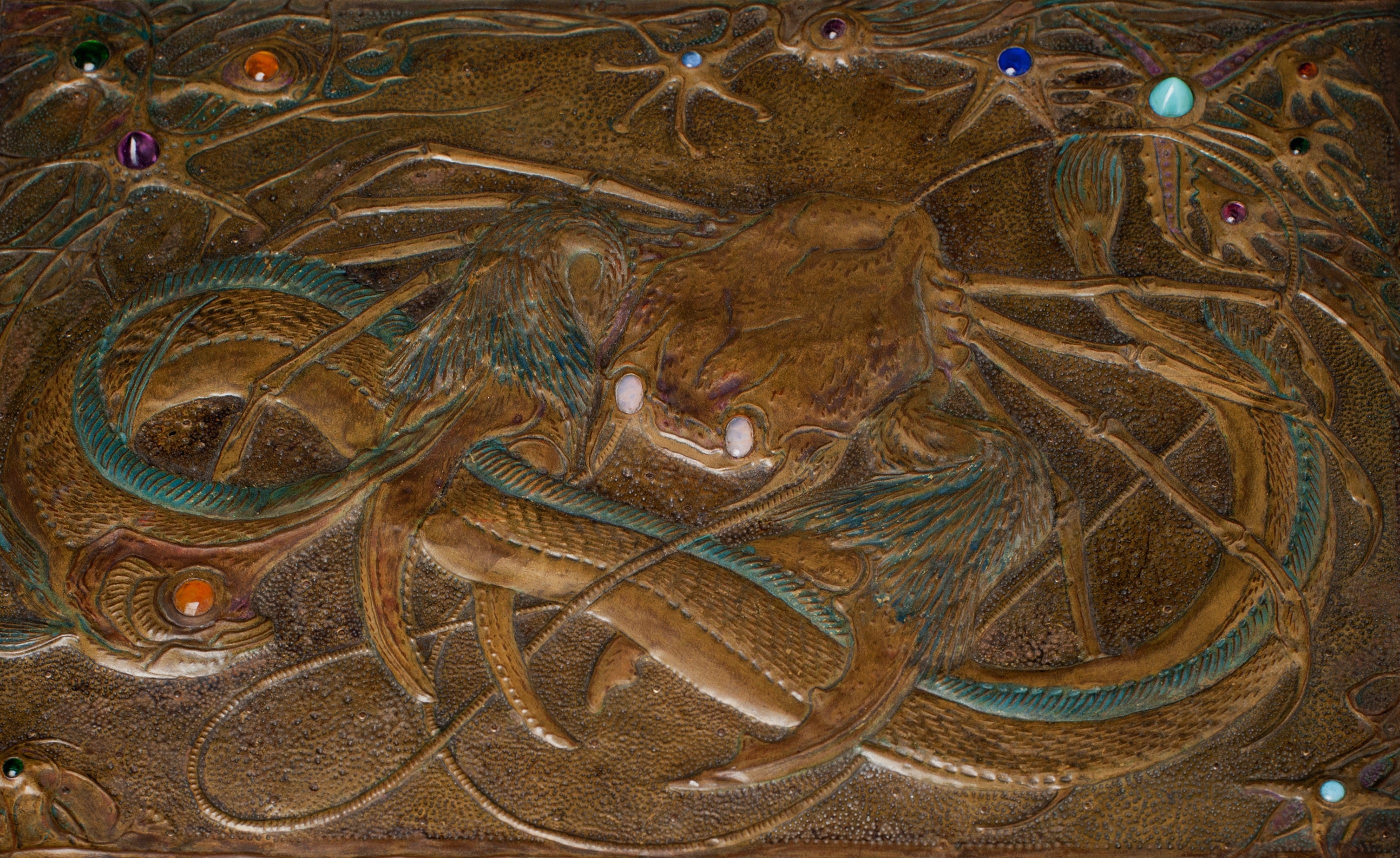
About the Seller
5.0
Platinum Seller
Premium sellers with a 4.7+ rating and 24-hour response times
Established in 2013
1stDibs seller since 2016
92 sales on 1stDibs
Typical response time: 1 hour
- ShippingRetrieving quote...Shipping from: Chicago, IL
- Return Policy
Authenticity Guarantee
In the unlikely event there’s an issue with an item’s authenticity, contact us within 1 year for a full refund. DetailsMoney-Back Guarantee
If your item is not as described, is damaged in transit, or does not arrive, contact us within 7 days for a full refund. Details24-Hour Cancellation
You have a 24-hour grace period in which to reconsider your purchase, with no questions asked.Vetted Professional Sellers
Our world-class sellers must adhere to strict standards for service and quality, maintaining the integrity of our listings.Price-Match Guarantee
If you find that a seller listed the same item for a lower price elsewhere, we’ll match it.Trusted Global Delivery
Our best-in-class carrier network provides specialized shipping options worldwide, including custom delivery.More From This Seller
View AllR. Layni, Zeichnungen folio, "The Artist's Wife, Seated" Collotype plate VI
Located in Chicago, IL
Egon Schiele (1890 – 1918), AUSTRIA
“ART CANNOT BE MODERN, ART IS PRIMORDIALLY ETERNAL.” -SCHIELE
Defiantly iconoclastic in life and art, Egon Schiele is esteemed for his masterfu...
Category
1910s Vienna Secession Portrait Prints
Materials
Paper
E. Strache, Handzeichnungen folio, "Self-Portrait" Collotype plate
By (after) Egon Schiele
Located in Chicago, IL
after Egon Schiele (1890 – 1918), AUSTRIA
“ART CANNOT BE MODERN, ART IS PRIMORDIALLY ETERNAL.” -SCHIELE
Defiantly iconoclastic in life and art, Egon Schiele is esteemed for his mas...
Category
1920s Vienna Secession Portrait Prints
Materials
Paper
R. Layni, Zeichnungen folio, "Woman with Greyhound" Collotype plate III
Located in Chicago, IL
Egon Schiele (1890 – 1918), AUSTRIA
“ART CANNOT BE MODERN, ART IS PRIMORDIALLY ETERNAL.” -SCHIELE
Defiantly iconoclastic in life and art, Egon Schiele is esteemed for his masterful...
Category
1910s Vienna Secession Portrait Prints
Materials
Paper
R. Layni, Zeichnungen folio, "One-Year-Volunteer Private" Collotype plate V
Located in Chicago, IL
Egon Schiele (1890 – 1918), AUSTRIA
“ART CANNOT BE MODERN, ART IS PRIMORDIALLY ETERNAL.” -SCHIELE
Defiantly iconoclastic in life and art, Egon Schiele is esteemed for his masterful...
Category
1910s Vienna Secession Portrait Prints
Materials
Paper
Max Eisler Eine Nachlese folio “Garden Path with Chickens” collotype print
By (after) Gustav Klimt
Located in Chicago, IL
After Gustav Klimt, Max Eisler #26, Bauerngarten mit Hühnern; multi-color collotype after 1916 painting in oil on canvas. The original was destroyed by fire in May 1945 at Immendorf Castle, Lower Austria.
Landscapes, for Klimt, are vehicles to convey universal themes such as procreation and the mysteries of life. Using a highly personal language of symbols, Klimt creates a voluptuous scene of fertility, fecundity and domesticity. Klimt uses a similarly lustrous palette of pearly iridescence for the path as he had for many of his female nudes. This feminine quality is intensified by the tunnel-effect produced by the walls of colorful floral blooms whose leafy stalks are redolent with wild abundance at the height of summer.The passage leads to a green covered arbor, womb-like, which contains a simple wooden table and a bench. Human presence is unmistakeable.The two chickens shown in the path provide the link to engage with this scene cerebrally and emotionally. Protective and maternal, the mother hens do somewhat bar one’s path, but by no means in a menacing way. The experiential aspect of walking forward and ignoring those chickens, certain that they will dodge out of the way, heightens the rational with the intuitive senses creating the illusion and feeling that the flanking floral walls are parting to provide clear passage to within. Seen in this context, the age old conundrum to divine what came first, the chicken or the egg, begs the question of the greatest mystery of all. One’s relationship to procreation itself, Klimt shows us, is interwoven all around us. Far from banal, this universal quality of the natural world is fraught with thrilling wonder.
GUSTAV KLIMT EINE NACHLESE (GUSTAV KLIMT AN AFTERMATH), a portfolio of 30 collotypes prints, 15 are multi-color and 15 are monochrome, on chine colle paper laid down on heavy cream-wove paper with deckled edges; Max Eisler, Editor-Publisher; Osterreichischer Staatsdruckerei (Austrian State Printing Office), Printer; in a limited edition of 500 numbered examples of which: 200 were printed in German, 150 were printed in French and 150 were printed in English; Vienna, 1931.
2018 marks the 100th anniversary of Gustav Klimt’s death. It is a fitting time to reflect upon the enduring legacy and deep impact of his art. Recognizing this need for posterity with uncanny foresight, the publication of Gustav Klimt: An Aftermath (Eine Nachlese) provides a rare collection of work after Klimt which has proven to be an indispensable tool for Klimt scholarship as well as a source for pure visual delight.
Approximately 25 percent of the original works featured in the Aftermath portfolio have since been lost. Of those 30, six were destroyed by fire on 8 May 1945. On that fateful final day of WWII, the retreating Feldherrnhalle, a tank division of the German Army, set fire to the Schloss Immendorf which was a 16th century castle in Lower Austria used between 1942-1945 to store objects of art. All three of Klimt’s Faculty Paintings: Philosophy, Medicine and Jurisprudence (1900-1907), originally created for the University of Vienna, were on premises at that time. Also among the inventory of Klimt paintings in storage there was art which had been confiscated by the Nazis. One of the most significant confiscated collections was the Lederer collection which featured many works by Gustav Klimt such as Girlfriends II and Garden Path with Chickens...
Category
1930s Vienna Secession Landscape Prints
Materials
Paper
Max Eisler Eine Nachlese folio “House in a Garden” collotype print
By (after) Gustav Klimt
Located in Chicago, IL
After Gustav Klimt, Max Eisler #9, Haus Im Garten; aka Forester’s House in Weissenbach II; multi-color collotype after 1914 painting in oil on canvas.
GUSTAV KLIMT EINE NACHLESE (GU...
Category
1930s Vienna Secession Landscape Prints
Materials
Paper
You May Also Like
portrait Angie
Located in Roma, GB
free shipping standard parcel available
to be confirmed while submitting the order
artist: Anastasia Aureum
paper print
limited edition
hand signed
About the artwork:
This portra...
Category
21st Century and Contemporary Vienna Secession Figurative Prints
Materials
Paper, Color, Digital
portrait print Emerald boy
Located in Roma, GB
portrait of a boy
limited edition
hand signed
print on paper
Category
2010s Vienna Secession Portrait Prints
Materials
Paper, Color
$659 Sale Price
75% Off
Original Vintage Secession Poster celebrating the emperor's jubilee
Located in Zurich, CH
Original Vintage Poster by the Austrian artist Ferdinand Ludwig Graf, a member of the Hagenbund. This Viennese artist association moved as soon a...
Category
Early 1900s Vienna Secession Figurative Prints
Materials
Paper
SCULPTURES DANS L'ATELIER
By Alberto Giacometti
Located in Aventura, FL
Hand signed and numbered by the artist. Etching on wove paper. Lust 185. Published by Galerie Beyeler, Basel. Edition 52/150.
Artwork is in overall excellent condition. White spot...
Category
1960s Expressionist Figurative Prints
Materials
Paper, Etching
VERA
By Nicola Simbari
Located in Aventura, FL
Serigraph on paper. Hand signed and numbered by the artist. Artwork appears to be in excellent condition. Artwork has not been examined outside the matting. Matted size: approx. 37 x...
Category
1970s Expressionist Portrait Prints
Materials
Paper, Screen
$900 Sale Price
25% Off
LA FAMILLE DU CIRQUE
By Nicola Simbari
Located in Aventura, FL
Serigraph on paper. Hand signed and numbered by the artist. Artwork appears to be in excellent condition. Artwork has not been examined outside the matting. Artwork size: 30 x 33 in....
Category
1990s Expressionist Portrait Prints
Materials
Paper, Screen
$900 Sale Price
25% Off

